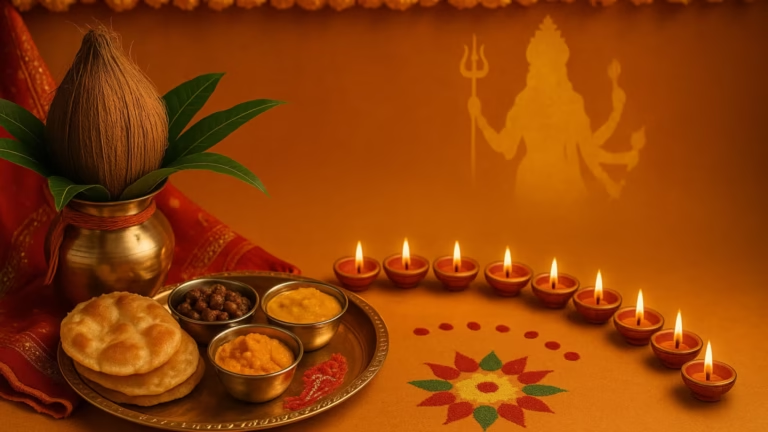On the sacred banks of the Chandrabhaga River lies the holy town of Pandharpur, where every grain is steeped in devotion. This is where Lord Vitthal, affectionately called ‘Vithoba’ or ‘Pandurang’ by millions of devotees, resides. His dark and captivating idol draws everyone to itself. But what most captures people’s attention and sparks curiosity is his unique pose — standing with both hands placed firmly on his waist. Why are Lord Vitthal’s hands on his waist? This is not just a pose — it is a symbol of devotion, waiting, and profound spiritual meaning. Its roots lie in a deep story of a great devotee, without which the essence of this form of Vithoba remains incomplete.
This is the story of Bhakt Pundalik — a man who set such an example of service that even the Supreme Lord came to his doorstep and waited for him.
In the beginning, Pundalik lived a life similar to many modern youths. He resided with his parents, Janudev and Satyavati, in a forest named Dindirvan. Before marriage, he was a dutiful son, but after falling under the influence of his wife, he grew neglectful of his elderly parents. He began to disrespect them, speak harshly, and his wife supported this behavior. Despite witnessing the sorrow of his parents, Pundalik’s heart remained unmoved.
Read Also: How to Perform Shravan Somvar Puja? Complete Guide, Rituals, and Significance
The height of his cruelty came when Pundalik and his wife decided to go on a pilgrimage. While they rode horses, they forced their aged parents to walk. During their journey, they stopped at the sacred ashram of the renowned sage Kukkut Rishi for the night.
The ashram’s atmosphere was serene and divine. In the last quarter of the night, Pundalik awoke and witnessed an astonishing sight. He saw three beautiful yet sorrowful women in dirty, torn sarees enter the ashram. They cleaned the floor, washed the sage’s clothes, and completed various chores. But when they exited, their clothes were pure white and their faces glowed with divine light.
Amazed, Pundalik ran after them and bowed at their feet, asking who they were. Initially reluctant, they eventually replied, “We are none other than the three sacred rivers of India — Ganga, Yamuna, and Saraswati. People bathe in our waters to wash away their sins, and we bear the burden of those sins. But by serving a true parent-devotee like Kukkut Rishi, we regain our purity. His service to his parents is so powerful that it washes away even our impurities.”
These words pierced Pundalik’s heart like an arrow. He realized that the true pilgrimage was not in Kashi, but right at home — at the feet of his parents. Tears of repentance welled up in his eyes. From that moment, he vowed to dedicate the rest of his life to serving his parents.
Pundalik brought his parents back home and immersed himself in their service. He fetched water, massaged their feet, fed them, and fulfilled every command — all with sincerity, repentance, and selfless devotion. His fame as a devoted son spread far and wide.
How can such true devotion remain hidden from the Lord? Seated in Dwarka, Lord Krishna, moved by Pundalik’s unwavering dedication, set out to meet his devotee with his consort Rukmini.
One evening, while Pundalik was massaging his father’s feet with his head resting in his lap, Lord Krishna arrived at his doorstep and lovingly called, “Pundalik, open the door! I have come to see you.”
Pundalik recognized the divine voice. He knew his beloved Lord had come to bless him. For a moment, he wanted to jump up and run to fall at the Lord’s feet. But then he remembered his duty — his father was asleep, and his service was his highest dharma.
Humbly, without moving, he turned toward the door and said, “O Lord! I recognize You. You are my revered deity. I am blessed that You came to see me. But at this moment, my father is resting, and I am serving him. I cannot abandon this service. For me, this duty is greater than even Your worship.”
Hearing this, Lord Krishna smiled — he was testing his devotee’s devotion.
Pundalik continued, “O Merciful One! I request You to wait for a while. There is a brick (called ‘Veet’ in Marathi) in my courtyard. Please use it as a seat and stand upon it until my father wakes. I shall then come and welcome You properly.”
Saying this, he returned to his service as if nothing had happened.
Lord Krishna was deeply pleased. What the devotee throws away, the Lord accepts with reverence. He stood upon that simple brick — more honored than a royal throne — and placed His hands on His waist, waiting for His devotee.
This form was extraordinary. The hands on the waist showed He was not there to give boons or assurances but to witness the devotion of His devotee. It was the stance of a witness — a symbol of control over the senses. Placing hands on the waist also signifies that the ocean of worldly life is only waist-deep — and those who reach that point are helped across by the Lord.
When morning came, and Pundalik’s father awoke, Pundalik completed his service and rushed to the door. There he saw his deity, still standing on the brick, now transformed into a divine idol. Overcome with emotion, Pundalik sought forgiveness and requested the Lord to remain in that form forever, blessing devotees.
The Lord accepted his request. Since He stood on a “Veet” (brick), He became known as ‘Vitthal.’ The place established by Pundalik came to be known as Pandharpur, the most sacred site for the Warkari sect.
Thus, Lord Vitthal standing with hands on His waist is not merely a mythical event — it is a powerful message: Seva Parmo Dharma — service is the highest form of worship. It teaches us that selfless service to parents and duty is true devotion. Lord Vitthal’s posture seems to say, “Do your duty with sincerity; I am here waiting for you, witnessing every genuine effort.” It is a living symbol of patience, control, and divine love — still drawing millions of Warkaris to Pandharpur today.
Jay Jay Ram Krushna Hari!
Whatsapp Channel Link :–https://whatsapp.com/channel/0029VbB0KvuIHphFXKcwyq3B
Click Here To Read In Hindi: भगवान विठ्ठल की प्रतिमा में हाथ कमर पर क्यों दर्शाए जाते हैं?…



